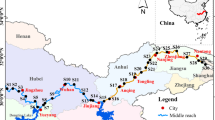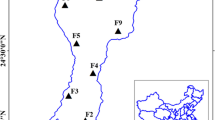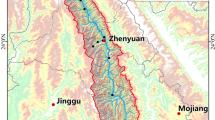Abstract
To evaluate the ecosystem health of Qin River, a main tributary of the Yellow River, a planktonic index of biotic integrity (P-IBI) that includes phytoplankton and zooplankton was established based on five metrics using a dataset covering 61 sampling sites in Qin River and its largest tributary the Dan River from October to November 2020. First, an index based on land use pattern and water quality was constructed to select reference sites and impaired sites. Then, five of an initial 38 candidate metrics (phytoplankton density, Palmer algal genus pollution index, zooplankton biomass/phytoplankton biomass, zooplankton Margalef richness index, and zooplankton Simpson diversity index) were selected to establish P-IBI based on their ranges, sensitivity, and redundancy. Finally, five statuses (excellent, good, fair, poor, and very poor) were classified by ratio score method on the basis of their final P-IBI scores. Sites with “excellent and good” and “poor and very poor” status accounted for 26.2% and 49.2%, respectively. “Very poor” sites were mainly located in the Dan River, and “poor” sites were mainly located in the middle reach of the Qin River and upper-middle reach of the Dan River in Jincheng region. Significantly negative correlations between Cl−, SO42−, and F− concentrations and P-IBI values indicated that the P-IBI might reflect domestic and industrial wastewater pollution in the Qin and Dan River in Jincheng region. The P-IBI strongly differentiated reference and impaired sites, suggesting the suitability of the index in the study.






Similar content being viewed by others
Data availability
Data can be requested from the corresponding author.
References
Arman NZ, Salmiati S, Said MIM, Aris A (2019) Development of macroinvertebrate-based multimetric index and establishment of biocriteria for river health assessment in Malaysia. Ecol Indic 104:449–458. https://doi.org/10.1016/j.ecolind.2019.04.060
Cai WW, Xia JH, Yang MZ, Wang WM, Dou CB, Zeng Z (2020) Cross-basin analysis of freshwater ecosystem health based on a zooplankton-based index of biotic integrity: models and application. Ecol Indic 114:106333. https://doi.org/10.1016/j.ecolind.2020.106333
Carpenter KE, Johnson JM, Buchanan C (2006) An index of biotic integrity based on the summer polyhaline zooplankton community of the Chesapeake Bay. Mar Environ Res 62(3):165–180. https://doi.org/10.1016/j.marenvres.2006.03.009
Çelekli A, Kayhan S, Çetin T (2020) First assessment of lakes’ water quality in Aras River catchment (Turkey); application of phytoplankton metrics and multivariate approach. Ecol Indic 117:106706. https://doi.org/10.1016/j.ecolind.2020.106706
Chen K, Hughes RM, Xu S, Zhang J, Cai DS, Wang BX (2014) Evaluating performance of macroinvertebrate-based adjusted and unadjusted multi-metric indices (MMI) using multi-season and multi-year samples. Ecol Indic 36:142–151. https://doi.org/10.1016/j.ecolind.2013.07.006
Chen XJ, Li X, Li JJ (2021) Pollution indicator species and evaluation of water quality in Wuliangsuhai Lake. Ecol Sci 40(3):231–237 (In Chinese)
Cheng R, Chen HR, Yuan C, Hou F, Cao XX, Zhen X, Zeng FG, Li ZH (2021) Characteristics of plankton community structure in Shahe Reservoir of the North Cannal. Acta Sci Circum 41(1):239–246 (In Chinese)
Cox B, Oeding S, Taffs K (2019) A comparison of macroinvertebrate-based indices for biological assessment of river health: a case example from the sub-tropical Richmond River Catchment in northeast New South Wales, Australia. Ecol Indic 106:105479. https://doi.org/10.1016/j.ecolind.2019.105479
Feng B, Zhang M, Chen JF, Xu J, Xiao BD, Zhou M, Zhang M (2021) Reduction in the phytoplankton index of biotic integrity in riverine ecosystems driven by industrial activities, dam construction and mining: a case study in the Ganjiang River, China. Ecol Indic 120:106907. https://doi.org/10.1016/j.ecolind.2020.106907
Houssou AM, Adjahouinou DC, Bonou CA, Montchowui E (2020) Plankton index of biotic integrity (P-IBI) for assessing ecosystem health within the Ouémé River basin, Republic of Benin. Afr J Aquat Sci 45(4):452–465. https://doi.org/10.2989/16085914.2020.1736980
Kane DD, Gordon SI, Munawar M, Charlton MN, Culver DA (2009) The planktonic index of biotic integrity (P-IBI): an approach for assessing lake ecosystem health. Ecol Indic 9:1234–1247. https://doi.org/10.1016/j.ecolind.2009.03.014
Kelly MG, Whitton BA (1995) The Trophic Diatom Index: a new index for monitoring eutrophication in rivers. J Appl Phycol 7(4):433–444. https://doi.org/10.1007/bf00003802
Li JP, Dong SK, Liu SL, Yang ZF, Peng MC, Zhao C (2013) Effects of cascading hydropower dams on the composition, biomass and biological integrity of phytoplankton assemblages in the middle Lancang-Mekong River. Ecol Eng 60:316–324. https://doi.org/10.1016/j.ecoleng.2013.07.029
Li XX (2019) Water quality assessment and influencing factor analysis in the Jincheng section of Qinhe River Basin. Jincheng University of Finance & Economics, Shanxi, China 1-65. In Chinese
Li RJ, Qi XR, Wang YC, Zhang JY, Ren J, Shen HB (2019) Spatial temporal characteristics of zooplankton community structure and the relationship with environmental factors in the Shaanxi Section of Yellow River. J Hydro-Ecol 40(6):54–60 (In Chinese)
Li YL, Li YF, Xu ZX, Li L (2016) Assessment of the Huntai River in China using a multimetric index based on fish and macroinvertebrate assemblages. J Freshwater Ecol 31(2):169–190. https://doi.org/10.1080/02705060.2015.1070109
Lin L, Wang FF, Chen H, Fang H, Zhang TY, Cao WZ (2021) Ecological health assessments of rivers with multiple dams based on the biological integrity of phytoplankton: a case study of North Creek of Jiulong River. Ecol Indic 121:106998. https://doi.org/10.1016/j.ecolind.2020.106998
Lv XM, Zhang J, Liang P, Zhang XY, Yang K, Huang X (2020) Phytoplankton in an urban river replenished by reclaimed water: features, influential factors and simulation. Ecol Indic 112:106090. https://doi.org/10.1016/j.ecolind.2020.106090
Ma Y (2020) Correlation between dynamic changes of phytoplankton community structure and environmental factors in Harbin section of the Songhua River. Harbin Normal University 5–119. In Chinese
Pielou EC (1966) Species-diversity and pattern-diversity in the study of ecological succession. J Theor Biol 10(2):370–383. https://doi.org/10.1016/0022-5193(66)90133-0
Palmer CM (1969) A composite rating of algae tolerating organic pollution. J Phycol 5(1):78–82. https://doi.org/10.1111/j.1529-8817.1969.tb02581.x
Saeed A, Hashmi I (2014) Evaluation of anthropogenic effects on water quality and bacterial diversity in Rawal Lake, Islamabad. Environ Monit Assess 186:2785–2793. https://doi.org/10.1007/s10661-013-3579-3
Shannon CE, Weaver W (1998) The Mathematical Theory of Communication. University of Illinois Press, London.
Xuan S, Liu J, You X, Bao K, Meng B, Chen B (2017) Evaluation of river habitat integrity based on benthic macroinvertebrate-based multi-metric model. Ecol Model:63–76. https://doi.org/10.1016/j.ecolmodel.2016.07.001
Sui HC, Wang JH, Li Z, Zeng Q, Liu X, Ren L, Liu CY, Zhu YN, Lv LX, Che Q, Liu X (2020) Screening of ecological impact assessment indicators in urban water body restoration process itle. Ecol Indic 113:106198. https://doi.org/10.1016/j.ecolind.2020.106198
Wang YK, Stevenson RJ, Metzmeier L (2005) Development and evaluation of a diatom-based Index of Biotic Integrity for the Interior Plateau Ecoregion, USA. J N Am Benthol Soc 24(4):990–1008. https://doi.org/10.1899/03-028.1
Wan XH, Yang T, Zhang Q, Wang W, Wang YY (2021) Joint effects of habitat indexes and physic-chemical factors for freshwater basin of semi-arid area on plankton integrity-a case study of the Wei River Basin. China Ecol Indic 120:106909. https://doi.org/10.1016/j.ecolind.2020.106909
Wang M, Yang BH, Ma SQ, Yin XW, Xu ZX (2020) Relationship between phytoplankton functional groups and environmental factors in North Canal in Beijing. Chin J Fish 33(02):70–76 (In Chinese)
Wang X, Guo KJ, Li XX, Pang WT, You QM, Wang QX (2021) Construction of phytoplanktonic index of biotic integrity and evaluation of water ecological health in Dianshan Lake, China. J Shanghai Norm Univ (Natural Sciences) 50(1):39–49 (In Chinese)
Wang S, Zhang Q, Yang T, Zhang L, Li X, Chen J (2019a) River health assessment: proposing a comprehensive model based on physical habitat, chemical condition and biotic structure. Ecol Indic 103:446–460. https://doi.org/10.1016/j.ecolind.2019.04.013
Wang X, Liu Y, Yin XY, Zhao XR, Guo R, Zheng BH (2019b) Development and evaluation of a planktonic integrity index (PII) for Jingpo Lake, China. J Limnol 78(1):135–146. https://doi.org/10.4081/jlimnol.2019.1855
Wang S, Yang T, Li XP, Chen J (2019c) Zooplankton community structure and the water quality in the Wei River Basin. Acta Hydrobiol Sin 43(6):1333–1344 (In Chinese)
Wei F (2002) Water and exhausted water monitoring analysis method. China Environmental Science Press, Beijing (In Chinese)
Wu JT (1999) A generic index of diatom assemblages as bioindicator of pollution in the Keelung River of Taiwan. Hydrobiologia 397:79–87. https://doi.org/10.1023/A:1003694414751
Wu N, Schmalz B, Fohrer N (2012) Development and testing of a phytoplankton index of biotic integrity (P-IBI) for a German lowland river. Ecol Indic 13:158–167. https://doi.org/10.1016/j.ecolind.2011.05.022
Wu ZS, Kong M, Cai YJ, Wang XL, Li KY (2019) Index of biotic integrity based on phytoplankton and water quality index: do they have a similar pattern on water quality assessment? A study of rivers in Lake Taihu Basin, China. Sci Total Environ 658:395–404. https://doi.org/10.1016/j.scitotenv.2018.12.216
Xiong W, Ni P, Chen YY, Gao YC, Li SG, Zhan AB (2019) Biological consequences of environmental pollution in running water ecosystems: a case study in zooplankton. Environ Pollut 252:1483–1490. https://doi.org/10.1016/j.envpol.2019.06.055
Xu ZX (2005) Single factor water quality identification index for environmental quality assessment of surface water. J Tongji Univ (Natural Science) 33:321–325 (In Chinese)
Yao N, Feng B, Zhang M, He L, Zhang H, Liu ZG (2021) Impact of industrial production, dam construction, and agriculture on the Z-IBI in river ecosystems: a case study of the Wanan River Basin in China. Water 13:123. https://doi.org/10.3390/w13020123
You QH, Yang WJ, Jian MF, Hu QW (2021) A comparison of metric scoring and health status classification methods to evaluate benthic macroinvertebrate-based index of biotic integrity performance in Poyang Lake wetland. Ecol Indic 761:144112. https://doi.org/10.1016/j.scitotenv.2020.144112
Zhang SS, Xu HZ, Zhang YF, Li YF, Li YZ, Wei JL, Pei HY (2020a) Variation of phytoplankton communities and their driving factors along a disturbed temperature river-to-sea ecosystem. Ecol Indic 118:106776. https://doi.org/10.1016/j.ecolind.2020.106776
Zhang JF, Hu XH, Ma PM, Chen W, Hu JX (2021) Seasonal succession characteristics of phytoplankton functional groups and key driving factors in Tangpu Reservoir. Journal of Hydro-Ecology 42(03):55–62 (In Chinese)
Zhang Y, Ban X, Li E, Wang Z, Xiao F (2020b) Evaluating ecological health in the middle-lower reaches of the Hanjiang River with cascade reservoirs using the Planktonic index of biotic integrity (P-IBI). Ecol Indic 114:106282. https://doi.org/10.1016/j.ecolind.2020.106282
Zhang Y, Cheng L, Kong M, Li W, Gong ZJ, Zhang L, Wang XL, Cai YJ, Li K (2019) Utility of a macroinvertebrate-based multimetric index in subtropical shallow lakes. Ecol Indic 106:105527. https://doi.org/10.1016/j.ecolind.2019.105527
Zhao K, Song K, Pan YD, Wang LZ, Da LG, Wang QX (2017) Metacommunity structure of zooplankton in river networks: roles of environmental and spatial factors. Ecol Indic 73:96–104. https://doi.org/10.1016/j.ecolind.2016.07.026
Zhao YW, Zhou LQ, Dong BQ, Dai C (2019) Health assessment for urban rivers based on the pressure, state and response framework-a case study of the Shiwuli River. Ecol Indic 99:324–331. https://doi.org/10.1016/j.ecolind.2018.12.023
Zhu H, Hu XD, Wu PP, Chen WM, Wu SS, Li ZQ, Zhu L, Xi YL, Huang R (2021) Development and testing of the phytoplankton biological integrity index (P-IBI) in dry and wet seasons for Lake Gehu. Ecol Indic 129:107882. https://doi.org/10.1016/j.ecolind.2021.107882
Acknowledgements
The authors thank their colleagues at the Dalian Ocean University for help with the identification of plankton as well as data analysis.
Funding
This study was supported by the National Natural Science Foundation of China (U1704241) and the Key Project of Research of Henan province in China (grant number 19A170006).
Author information
Authors and Affiliations
Contributions
Yanli Li conceived the study and drafted this manuscript. Linxia Li analyzed the hydrochemical compositions and investigated the plankton communities in Qin River in Jincheng region. Data collection and analysis were performed by Linxia Li. All authors read and approved the final manuscript.
Corresponding author
Ethics declarations
Ethics approval and consent to participate
Not applicable.
Consent for publication
Manuscript is approved by all authors for publication.
Competing interests
The authors declare no competing interests.
Additional information
Communicated by Thomas Hein.
Publisher's note
Springer Nature remains neutral with regard to jurisdictional claims in published maps and institutional affiliations.
Rights and permissions
Springer Nature or its licensor holds exclusive rights to this article under a publishing agreement with the author(s) or other rightsholder(s); author self-archiving of the accepted manuscript version of this article is solely governed by the terms of such publishing agreement and applicable law.
About this article
Cite this article
Li, Y., Li, L. Development and validation of the planktonic index of biotic integrity (P-IBI) for Qin River, a main tributary of the Yellow River in China. Environ Sci Pollut Res 30, 2622–2636 (2023). https://doi.org/10.1007/s11356-022-22348-7
Received:
Accepted:
Published:
Issue Date:
DOI: https://doi.org/10.1007/s11356-022-22348-7




